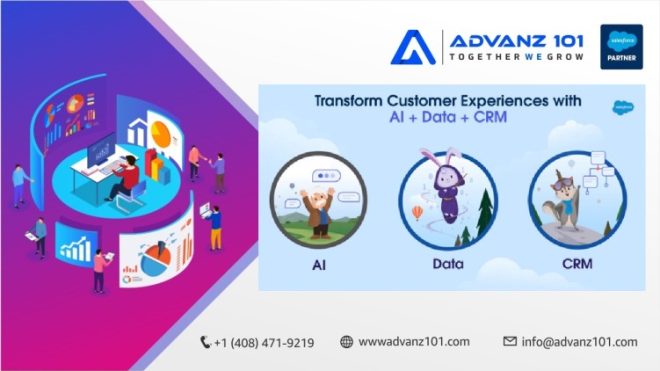Nowadays, frequently we have heard about AI, Data and CRM.
Salesforce product teams have been working smartly since announcing Data Cloud back at Dreamforce and Einstein GPT back at Trailblazer DX to get a lot of product innovation into recent releases so you can start transforming customer experiences by connecting the power of AI and Data in CRM.
I hope this article will help you to learn more about datacloud.
But before we get right into Data Cloud let’s understand a little bit. There are teams in your organization that are being asked to do more with less.
Many of these people are looking for ways to save time and companies today are saving time of Technology Resources with a unified data solution they are saving approximate 67% of tech resources time by freeing them up with modern data unification Solutions. Additionally, companies are also looking for ways to reduce costs and approximately 79% of companies have achieved cost reduction with AI.
Before we start with the Data Cloud. We first need to start with Data but having access to better data has not been getting any easier.
Think about everything you do or interact with in your life today this can be tracking your fitness and health data. All of your customer data is being generated and stored somewhere companies are no longer measuring by thousands but by hundreds of Zeta bytes and that’s all data sitting in different systems waiting for someone or something to do something with that data to make that data useful. Companies needs to learn how to harness this data and use it build exceptional customer experiences.
Data Integration is Both Complex and Vital
Doing this takes a tremendous amount of time and effort from your IT teams. Approximately 36% of IT’s time is spent in designing building and testing customer integration across systems.
- Volume of Data
- Siloed systems
- Integration time
- Maintenance costs
- Security and Compliance
- Technical expertise
If you have ever been on a project with multiple integrations. You may already be knowing that these integrations are expensive to maintain. It can be a pain to add more information to the integration changes can disrupt or even break the integrations but still having access to the main disparate data sources stored across systems is very vital now you may be wondering what are some other use cases for which we might need a data cloud.
Why Customer might need a Data Cloud
If they say the following things.
- We want to increase agent productivity by giving them quicker access to customer data.
- Our sales team is bogged down by bad data and it’s hurting their productivity.
- Our executives need to see the entire business across multiple orgs.
- We just merged and need to consolidate our Salesforce orgs.
- We need to leverage data across our enterprise to forecast better.
- We need to provide more personalized customer experiences.
- We want to increase efficiency by using AI and automation to improve employees’ jobs.
- We want access to all the engagement data to trigger incredible real-time experiences for customers.
- We need to get to a single view of our customer and their data.
- We need more intelligent insights to help our sales team know where to focus their time to increase revenue and productivity.
- We need to improve productivity by automating processes across orgs.
How Data Cloud Works

First, connect with all of your data sources to bring them together. Salesforce Data Cloud supports several out-of-the-box connectors such as connectors to every salesforce cloud such as Sales cloud, Service cloud, Marketing cloud, or Commerce cloud.
You can also able to connect data from googlecloud Storage, #amazons3, and Microsoft #azure .
There is the ability to pull in data near real-time streaming data from web and mobile sources.
There’s also the ability to pull the data from #apis integrated with #mulesoft via any point platform these connectors help to bring external data from #legacysystem systems or #datalake
After connecting all of your data from the numerous data sources, you must harmonize your data. Ingest and transform your data in streaming or batches. The challenges of the data that are coming are not yet uniform for example users are called Contacts in the Sales and Service Cloud while they are referred to as Subscribers in the Marketing cloud and possibly something else in a connected Legacy system.
We use a variety of data models in the data cloud to harmonize the data after harmonizing the data we use identity resolution to bring identities together and create a 360 view of each customer.
Once this is done you have a real-time unified profile that can be used with AI and BI tools for predictive insights such as AI models recommendations and data visualizations and finally, you can act on this data you can use one of the many activation targets data actions or flows that are available to start creating actions from your data.
Salesforce Data Cloud
The intelligent heart of customer engagement
Intelligent – Power Einstein with unified, customer data to personalize every interaction at scale.
Real-Time – Know your customers with unified profiles that change as they interact with your business.
Automated – Streamline any business process with the confidence of using the most up-to-date customer data.
Salesforce Data Cloud is a comprehensive platform that allows real-time know your customer with unified profiles. Data Cloud helps sales, service, and marketing teams to gain insight and make better decisions.
With many years of experience in Salesforce, BI, and associated Data technologies, Advanz101 Business Systems is a trusted partner of Salesforce CRM solutions and consulting services.
Learn more about how Advanz101 Systems can help you overcome the challenges of adopting Salesforce Data Cloud.
ADVANZ101 – Salesforce Regd. Consulting Partner
We encourage you to continue your understanding beyond this article. Please refer listed resources:
sforce.co/DataCloudQuickLook
sforce.co/AboutDataCLoud
sforce.co/IntroducingDataCloud


